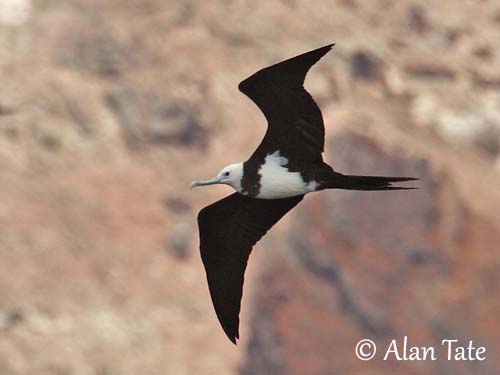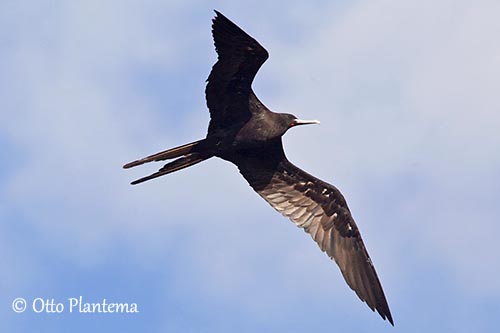
Fr: Frégate aigle-de-mer
Ang: Ascension Frigatebird
All: Adlerfregattvogel
Esp: Rabihorcado de Ascensión
Ita: Fregata aquila
Nd: Ascensionfregatvogel
Sd: Ascensionfregattfågel
Photographers:
Otto Plantema
Trips around the world
Alan & Ann Tate
AA Bird Photography
Text by Nicole Bouglouan
Sources :
HANDBOOK OF THE BIRDS OF THE WORLD vol 1 by Josep del Hoyo-Andrew Elliot-Jordi Sargatal - Lynx Edicions - ISBN: 8487334105
BirdLife International (BirdLife International)
Frigatebird returns to nest on Ascension for first time since Darwin – The Guardian
Red List of Threatened species
Page family Fregatidae
Summary cards
Ascension Frigatebird
Fregata aquila
Suliformes Order – Fregatidae Family
INTRODUCTION:
Like numerous islands, Ascension Island was a shelter for seabirds, including the Ascension Frigatebird. But in the 1800s, numerous rats were accidentally introduced by settlers and began to kill the chicks.
In order to eradicate the rats, cats were introduced too, but they also killed the frigatebird chicks. By 1836, only a few frigatebirds were remaining on the island. However, a colony of about 10,000 birds was established on Boatswain Bird Island, off Ascension east coast, from where predators were absent.
In 2002, the RSPB launched a programme to eradicate the feral cats from the island, and in 2006, Ascension Island was declared to be free of wild cats.
Six years later in 2012, two pairs of Ascension frigatebirds came back to the island for breeding, and both pairs laid eggs.
The return of these amazing birds is raising hopes for the future of this species, suggesting that there is a real chance of saving the Ascension frigatebird from extinction.
DESCRIPTION OF THE BIRD:
Biometrics:
Length: 89-96 cm
Wingspan: 196-200 cm
Weight: 1250 g
The typical adult male has brownish-black plumage with green and purple gloss. On the underwing, greater coverts and flight feathers are browner. The long tail is deeply forked.
The male has pinkish-orange to red gular pouch. During the breeding season, the pouch becomes bright red and is regularly inflated.
The bill is pale bluish-grey with hooked, darker tip. The eyes are dark brown, surrounded by narrow, bare, blackish eyering. Legs and feet are dark grey.

The female is mostly brownish-black but duller, with reduced green and purple gloss. The lesser upperwing-coverts show browner tinge. There is a dark brown to rusty brown broad collar extending from upper mantle to breast.
On the dark head, the bill is whitish to pale bluish, with darker blue rim around the base. The dark brown eyes are surrounded by bare, blue eyering. Legs and feet are pinkish.
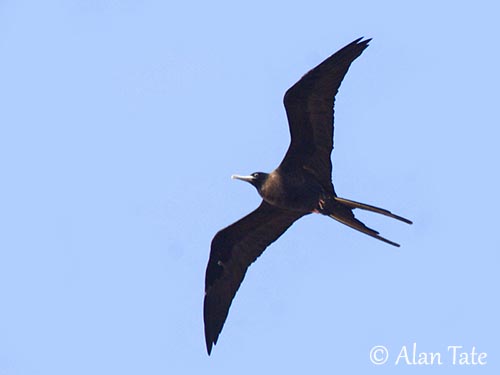
The female in pale morph has white abdomen, but this form could refer to birds breeding in subadult plumage.
Male in pale morph also said to exist.
The juvenile has white head and upperneck, a broad pectoral band usually broken along the centre, lower breast to vent are white, extending to side up to axillaries. On the upperparts, mantle, scapulars and lesser coverts are browner with pale-edged feathers.
The immature becomes darker on breast, but it needs several intermediate plumages before to gain the full adult plumage.
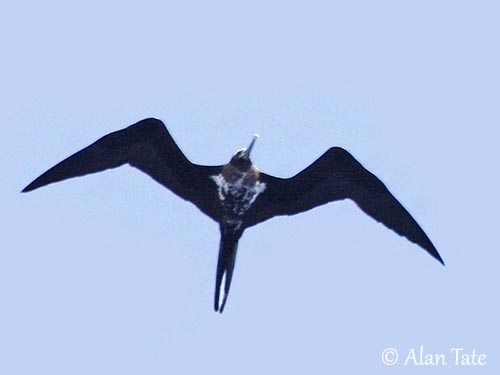
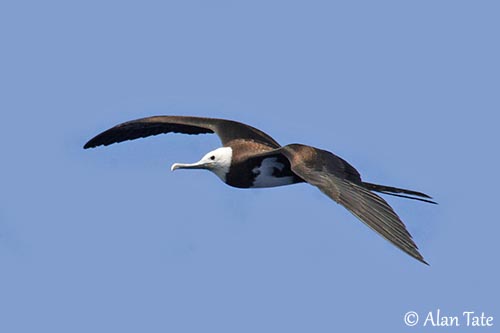
RANGE:
The Ascension Frigatebird’s main breeding range is Boatswain Bird Island, a small islet at less than 300 metres from the east coasts of Ascension Island in South Atlantic Ocean. Since 2012, one or two pairs are found on Ascension Island.
HABITAT:
The Ascension Frigatebird breeds among boulders, outcrops and guano. This species is the only one in the family Fregatidae that nests exclusively on the ground. The four other species nest both on the ground and in trees.
It forages in surrounding waters, rarely more than 150 kilometres from the island.
CALLS AND SONGS: SOUNDS BY XENO-CANTO
The Ascension Frigatebird male engages in strong bill-clapping while inflating the red gular pouch during displays. The female utters a high-pitched clucking cry. The chicks give squeals and groans while begging for food.
This species is often silent away from the nesting-sites.
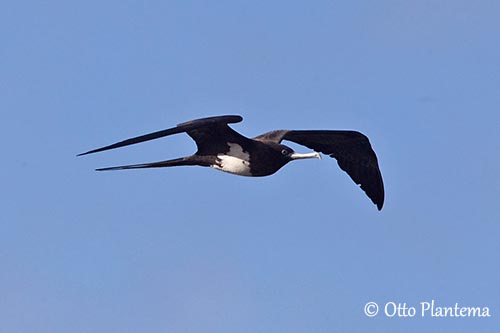
BEHAVIOUR IN THE WILD:
The Ascension Frigatebird feeds primarily on fish, mainly flying-fish, caught by surface-dipping. But it also takes newly hatched green turtles and Sooty Tern Chicks.
Kleptoparasitism is usually performed by females harassing smaller seabirds until they regurgitate their preys.
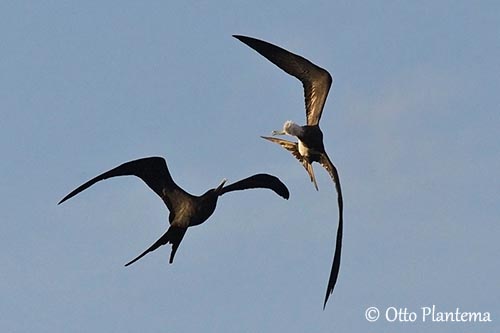
The Ascension Frigatebird breeds all year round. Several males display together, showing little aggression towards each other. They spread the wings to reveal the underwing, while inflating their red gular pouch, tipping the head back and pointing the bill skywards. They try to attract the attention of females. When a female flies over them, they quiver wings and head, and the bill is vibrating against the fully inflated pouch, producing a drumming noise.
If a female chooses a male, she flies down and joins it. Some ritual displays such as “head-snaking” are performed during the pair-formation. Then, both mates establish the territory. The site is strongly defended by both birds, using bill-clattering and bill-grappling against intruders. Copulation takes place at the nest-site, usually preceded by “head-waggling”. They are monogamous.
The Ascension Frigatebird is sedentary and forages within 150 km from its breeding areas. Some vagrants can be seen along the west coasts of Africa, S from Gulf of Guinea.
Two birds have been recorded in Scotland in 1953 and 2013.
The Ascension Frigatebird can fly at speeds of about 50 km/hour. It sometimes hangs motionless in the air for long periods. It mainly soars or glides, although on calm days, it can perform an active flight with series of deep, loose wingbeats.
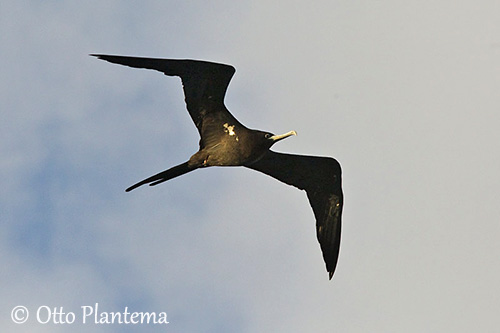
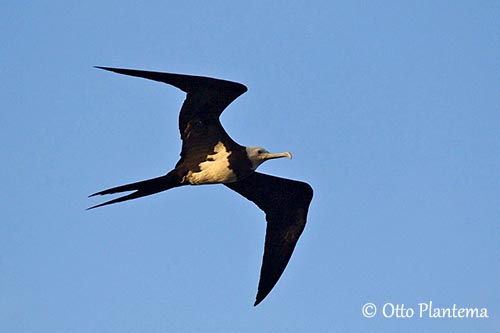
REPRODUCTION OF THIS SPECIES:
The Ascension Frigatebird can breed all year round, but mostly April-November/December. The peak laying occurs in October.
This species forms loose colonies on the ground, often alongside other species such as Masked Booby. The nest is on the ground among rocks and guano, on the flat top of Boatswain Bird Island or on cliff ledges. Some feathers can be used as lining.
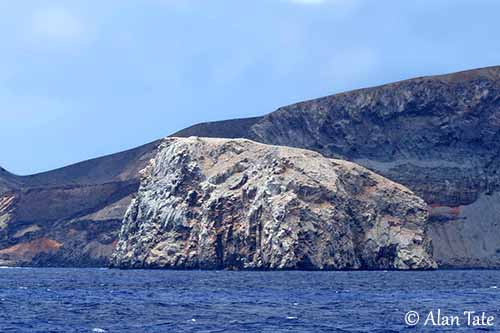
The female lays a single white egg. If the egg (or the chick) is lost, they probably lay a replacement clutch in 20-25% of the cases. Both parents share the incubation during 43-50 days, usually 44 days. The chick is naked at hatching, but it is covered in white down very soon. Both adults feed it by regurgitation. It fledges 6-7 months after hatching, and may remain 3-4 months or more with the adults.
PROTECTION / THREATS / STATUS:
The Ascension Frigatebird has tiny breeding range. The main threat remains the accidental introduction of feral cats. The birds can be caught on baited hooks and are threatened by longline fishery in the area.
The population is estimated at about 17,000-21,000 mature individuals (2001-2002).
The Ascension Frigatebird is currently classified as Vulnerable.
